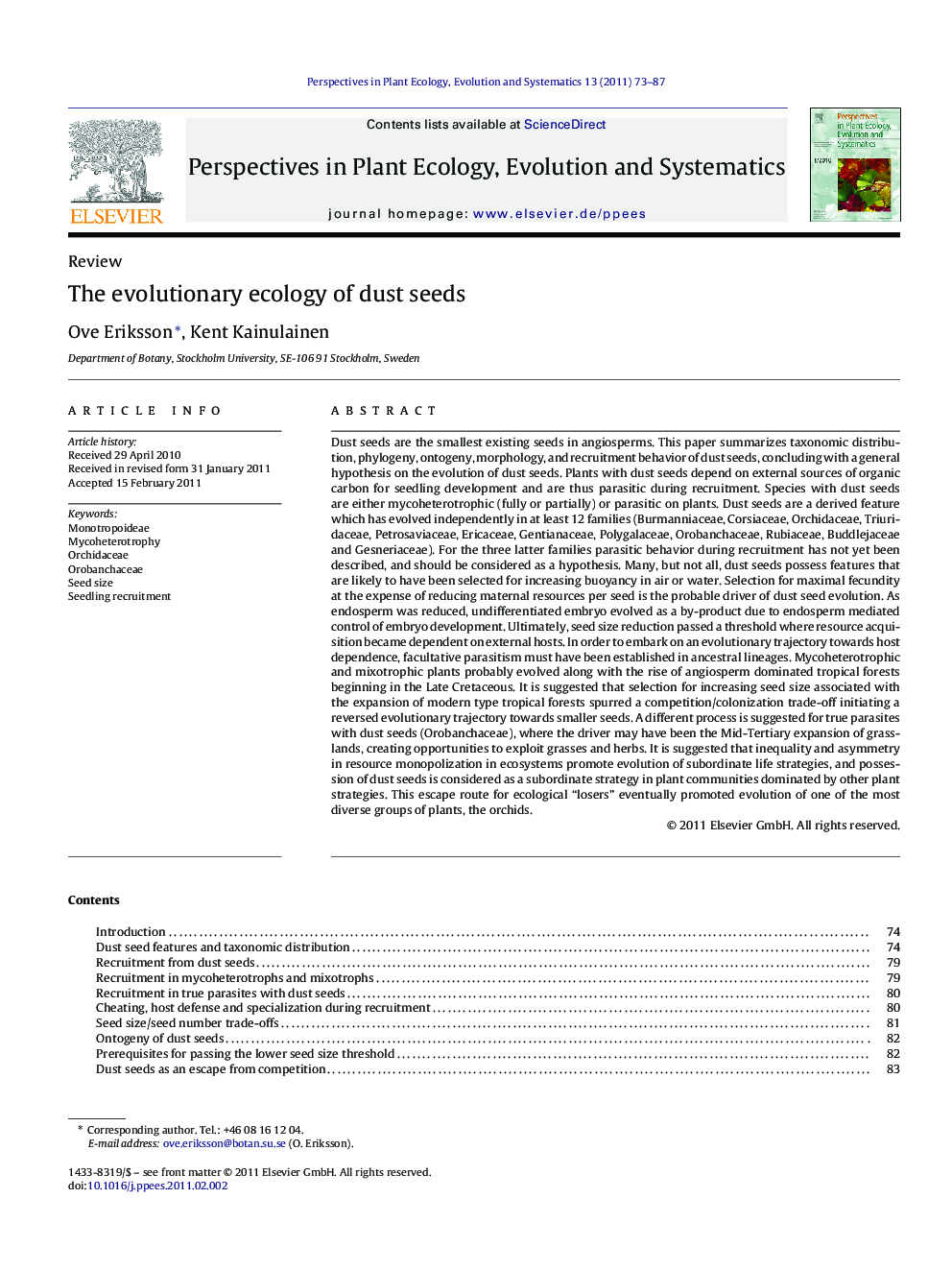| کد مقاله | کد نشریه | سال انتشار | مقاله انگلیسی | نسخه تمام متن |
|---|---|---|---|---|
| 4401156 | 1307063 | 2011 | 15 صفحه PDF | دانلود رایگان |
عنوان انگلیسی مقاله ISI
The evolutionary ecology of dust seeds
دانلود مقاله + سفارش ترجمه
دانلود مقاله ISI انگلیسی
رایگان برای ایرانیان
کلمات کلیدی
موضوعات مرتبط
علوم زیستی و بیوفناوری
علوم کشاورزی و بیولوژیک
بوم شناسی، تکامل، رفتار و سامانه شناسی
پیش نمایش صفحه اول مقاله

چکیده انگلیسی
Dust seeds are the smallest existing seeds in angiosperms. This paper summarizes taxonomic distribution, phylogeny, ontogeny, morphology, and recruitment behavior of dust seeds, concluding with a general hypothesis on the evolution of dust seeds. Plants with dust seeds depend on external sources of organic carbon for seedling development and are thus parasitic during recruitment. Species with dust seeds are either mycoheterotrophic (fully or partially) or parasitic on plants. Dust seeds are a derived feature which has evolved independently in at least 12 families (Burmanniaceae, Corsiaceae, Orchidaceae, Triuridaceae, Petrosaviaceae, Ericaceae, Gentianaceae, Polygalaceae, Orobanchaceae, Rubiaceae, Buddlejaceae and Gesneriaceae). For the three latter families parasitic behavior during recruitment has not yet been described, and should be considered as a hypothesis. Many, but not all, dust seeds possess features that are likely to have been selected for increasing buoyancy in air or water. Selection for maximal fecundity at the expense of reducing maternal resources per seed is the probable driver of dust seed evolution. As endosperm was reduced, undifferentiated embryo evolved as a by-product due to endosperm mediated control of embryo development. Ultimately, seed size reduction passed a threshold where resource acquisition became dependent on external hosts. In order to embark on an evolutionary trajectory towards host dependence, facultative parasitism must have been established in ancestral lineages. Mycoheterotrophic and mixotrophic plants probably evolved along with the rise of angiosperm dominated tropical forests beginning in the Late Cretaceous. It is suggested that selection for increasing seed size associated with the expansion of modern type tropical forests spurred a competition/colonization trade-off initiating a reversed evolutionary trajectory towards smaller seeds. A different process is suggested for true parasites with dust seeds (Orobanchaceae), where the driver may have been the Mid-Tertiary expansion of grasslands, creating opportunities to exploit grasses and herbs. It is suggested that inequality and asymmetry in resource monopolization in ecosystems promote evolution of subordinate life strategies, and possession of dust seeds is considered as a subordinate strategy in plant communities dominated by other plant strategies. This escape route for ecological “losers” eventually promoted evolution of one of the most diverse groups of plants, the orchids.
ناشر
Database: Elsevier - ScienceDirect (ساینس دایرکت)
Journal: Perspectives in Plant Ecology, Evolution and Systematics - Volume 13, Issue 2, 20 May 2011, Pages 73-87
Journal: Perspectives in Plant Ecology, Evolution and Systematics - Volume 13, Issue 2, 20 May 2011, Pages 73-87
نویسندگان
Ove Eriksson, Kent Kainulainen,